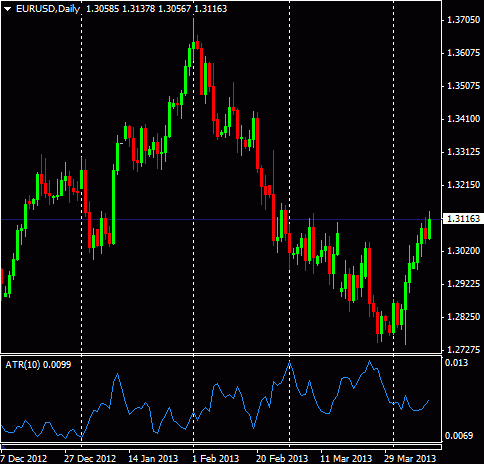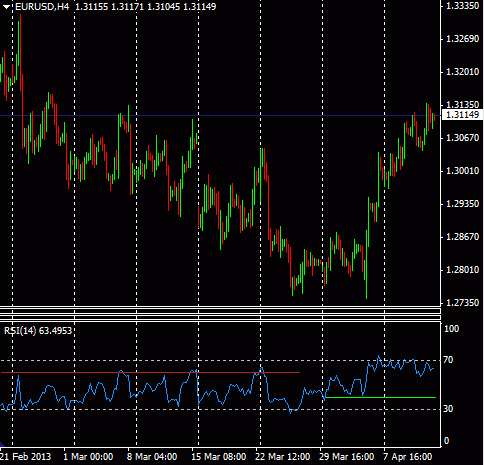Two Powerful Trading Indicators, and How I Use Them
Price is the ultimate indicator. Regardless of what indicator you use, it won’t tell you more than the actual price movement itself, because all indicators are derived from price. I prefer to trade without binary options indicators, since the price itself is what I trade. With that said, indicators do present price information in a different way, which can help us isolate moves or underlying strength or weakness we not see on the price chart. While I generally trade indicator free, but here are my two favorite indicators which I do use on occasion to clarify moves, hone in on high probability trades and help filter out the bad ones.
Average True Range (ATR)
By far the indicator I use the most. Simply put, ATR is the amount an asset moves in the day.
The indicator takes an average over a number of days (or bars), such as 10 or 20, to give you a representation of daily price movement of the asset. The average is based on the largest following number: Current High minus Current Low, Current High minus Previous Close or Current Low minus Previous Close. Luckily the indicator tool within your trading platform will calculate this all for you, so all you have to is look at the current indicator reading.
Figure 1. EUR/USD Daily with ATR

Source: Oanda – MetaTrader
Figure 1 shows the ATR over ten days–shown as “ATR (10)”– for the EUR/USD on Daily bars. Therefore, the current reading of 0.0099 means the EUR/USD is moving on average 99 pips per day. If you used a 5 minute chart, the reading you get would be a 10 period average of how much the EUR/USD moves in a 5 minute period.
So how does this reading help you make better trades? Assume it is near the end of the day, and the EUR/USD has already moved up 140 pips on the day and you want to take a long trade. Do you take it?
Maybe, but only if you believe something important is going on. Since the average daily movement is about 99 pips, it is quite likely that the EUR/USD is bit overextended (at 140 pips), having already moved well beyond average. That is not too say that if you go long/buy calls you won’t make money, but it does make you sit back and examine the trade to make sure it is worth taking.
I generally use this indicator as a filter. While wide ranging days happen (much larger than average), I like to trade based on statistics. If I get a signal to go long or short on an intra-day trade, and the asset has already moved well beyond the average, I will usually skip it and look for another trade which has more room to run.
Relative Strength Index (RSI)
Known as an oscillator, this indicator fluctuates between 0 and 100 and measures the speed and change of price. If you have watched business news or read some technical comments from traders, you will often hear the words “Overbought” or “Oversold.” While the speaker may be addressing something else, often technical analysts are referring to the current RSI reading when they use these words. A reading above 70 is typically overbought, while below 30 is oversold. Once an asset enters these area, a reversal is usually not far off.
But to me, timing is important and therefore standard overbought/oversold RSI readings are pretty much useless. For one, in a strong uptrend, the reading will be frequently above 70, but yet you want to be long most of the time. Same goes for a downtrend; the RSI will frequent the area below 30 and yet you want to be short/buying puts during downtrends.
I prefer to use the RSI in a “relative” fashion; comparing current RSI readings in uptrends to past uptrends, and current RSI readings in downtrends to past downtrends. This concept comes from Constance Brown’s book Technical Analysis for the Trading Professional. What the author finds is that in downtrends the RSI generally stays below 60, and that in uptrends it generally stays above 40.
Figure 2. EUR/USD 4 Hour Chart

Source: Oanda – MetaTrader
In figure 2, notice how the RSI shifts; during the downtrend it often touches below 40 and rarely gets above 60 (red line). But when the trend moves higher toward the right hand side of the chart, the RSI doesn’t move below 40 (green line) and spends much of the time above 60.
This is an excellent method for confirming trends, although some tolerance is often required. The RSI may squeak just beyond the levels mentioned, or the levels used may vary slightly by asset.
Recommended Brokers
Final Word
Indicators are derivatives of price. Generally I do not use indicators very much, as I prefer just to look at the actual price chart. Indicators can only provide this same price information, but may present it visually in a way that is preferable, or summarize the data for easier use. ATR is one such summarizing tool. It quickly gives you a number–the daily average range–you can work with. If an asset has moved well beyond its daily average range, it’s possible something important is happening, but more often than not I find the trade should simple be skipped if it requires the asset move even further.
The RSI presents price information in a different way, which can be quite useful for confirming trends or catching trend reversals. The RSI has different tendencies during downtrends than it does during uptrends. Typically in a downtrend the RSI stays below 60, and in uptrend stays above 40. When you notice the RSI shift from one tendency to another, the trend has likely reversed.